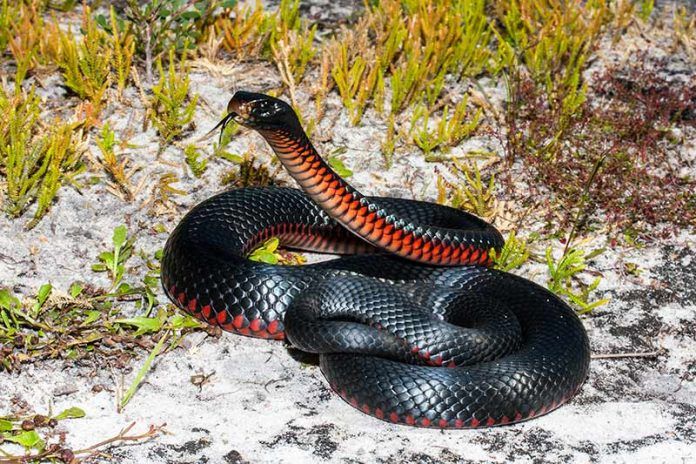Great green snakes, slithering black and red snakes, frightening brown snakes and constricting pythons, they all have every one of us caught in a sea of fear, chilled to the bone at the very thought of finding a snake slithering through the bush.
The trouble is, knowing what to do when you’re bailed up in your campsite by an errant red-bellied black snake or death adder. But the real trouble is knowing what to do if its stocky body is resting on your van floor in a tight coil, its arrow-shaped head flicking from side to side, tasting the air. And knowing what to do when this snake, in all of its menacing shades of grey or reddish-brown, decides to stay. Here’s a little help.
IN THE NEWS
In 2013, campers taking in the sun and nearby surf at a Coolum Beach caravan park were troubled when, as the local paper reported, they became aware they were sharing space with a transient nest of vipers.
The newspaper reported: “At least one red-belly black snake appears to have made its home in the hedge of one of the park’s permanent residents.”
The snake had been noticed for months, but residents were hard-pressed to do anything as it is a protected species and has to be in a dwelling before they’ll send the snake catcher. What’s more, there was a fear that campers and residents thought there was more than one snake.
The Sunshine Coast isn’t the only area with a ‘snakes around caravans’ story. A few years ago, a death adder bit a man in a caravan park near Broome.
The man was rushed to Broome Hospital. He had been returning from his evening shower when it is thought he stood on the snake in a darkened area.
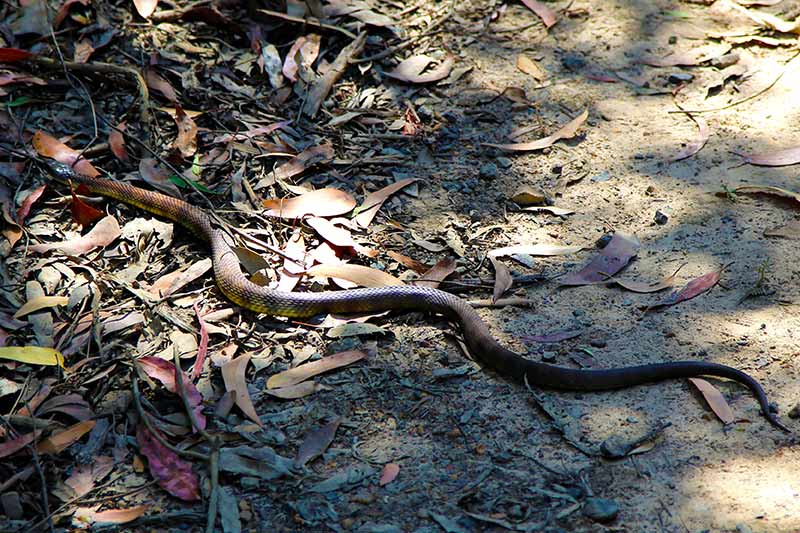
Snakes and caravans stories are not hard to find given deadly snake sightings are on the rise. You don’t need to be in the outback to see them. There are many reports of venomous reptiles in Australia’s capital cities.
Moreover, they’re not all yarns of harmless carpet pythons. On the contrary, many reports that include potent eastern brown, red-bellied black and tiger snakes are popping up in established inner-city suburbs. So finding one in or around your caravan is not unthinkable.
In fact, the hot summer means a higher risk of bites, with figures showing two-thirds of snake and spider fatalities occur in cities and towns and about 3000 snake bites occur in Australia each year. So here’s the expert advice on how to stay safe…
EXPERT SNAKE ADVICE
A Queensland Museum snake expert said staying safe was a difficult problem for caravanners, especially those in a remote location because “it depends on too many factors – what sort of snake it is, how large it is, whether or not it has dangerous venomous and how agitated it is”.
“The best advice is to keep the caravan door closed so the situation doesn’t arise. As for snakes that are outside the caravan, leave them alone and let them go on their way,” the expert said.
He also suggested that no matter where you were camping, or what sort of rig you used, it would be beneficial to know first aid procedures for snake bite. That included travellers carrying a well-equipped first aid kit that included pressure bandages.
Communication is also essential. The ability for caravanners to contact the ambulance or perhaps the Flying Doctor might be critical to patient survival if a bite occurs.
PROTECTED SPECIES
Travellers aren’t the only creatures that need protecting when there’s a human-snake encounter. The first thing to remember is you just can’t go ahead and try to kill it – that’s a bad idea.
Snakes are protected creatures and it is an offence to kill, injure or take snakes from the wild.
Snakes are significant middle-order predators that keep natural ecosystems working. A little samurai shovel action isn’t worth trying. You more likely to get bitten.
Experts say that snakes usually prefer to retreat when encountered but, if they feel threatened, they can become defensive. The advice is not to panic. Instead, keep a safe distance and allow the snake to move away.
STAY SNAKE SAFE
As stated, if you see a snake, the best way to avoid being bitten is simply to leave the snake alone. In addition:
- Wear boots and trousers or gaiters when bushwalking. Do not wear sandals or thongs.
- Be aware of where you are placing your feet.
- Do not put hands or feet in or under logs, rocks, hollows, crevices or debris without checking first that there is no snake there.
- When in the bush, check inside your shoes, clothes and sleeping bag before using them.
- Use a torch when walking around campsites or the bush at night.
- Do not interfere with a snake if pets or other people have already provoked it.
- Do not handle injured snakes. A hurt animal is a much more dangerous animal as it is fighting for its life.
- Know appropriate first aid for treating snake bites.
FIRST AID
If you are unlucky enough to be bitten, here is what you should and should not do. Assume all snakes are venomous and take the following action:
- Do not panic. Try to remain calm, lie down and immobilise the bitten area. It is unlikely that the bite will be life-threatening.
- Apply a bandage but do not block circulation. Take a broad bandage and bind along the limb starting at the bite area, at the same pressure as for a sprain. Then bandage down the limb and continue back up the entire limb over and above the bite area. This will help prevent the spread of the venom through the body. Do not remove the bandage. It is often easier to go over the top of clothing such as jeans rather than remove clothing. In an emergency, strips of clothing or pantyhose can be used instead of a bandage.
- Immobilise the limb with a splint. Lie down and keep the limb completely still until help arrives. Do not elevate the limb or attempt to walk or run. Movement will encourage the spread of the venom through the body.
- Do not attempt to catch the snake. All too often, the snake will bite again if an attempt is made to catch it. Identification of the snake species can be obtained through samples of the patient’s blood or urine, and from venom around the bite area. If the species of snake still remains uncertain, a poly-antivenene may be used, which is suitable for treatment of all venomous snake bites.
- Do not wash the wound. Venom left on the skin will help doctors identify the snake and administer the appropriate antivenene.
- Do not cut the wound. This will spread the venom into the bloodstream and can cause more serious injuries than the snake bite itself.
- Seek medical help. An antivenene may be required.
THE BIG FOUR
In ranking Australia’s most venomous snakes, it’s important to note that there’s a difference between most-venomous and most-deadly. Australia’s most venomous snake, by virtue of geography, is not the one that causes the most fatalities.
It’s perhaps academic to list snakes in order of venom potency. Frankly, one bite from any of the following will send you to the hospital or potentially to your maker. Nonetheless, these are Australia’s generally-agreed four most venomous snakes.
1. INLAND TAIPAN
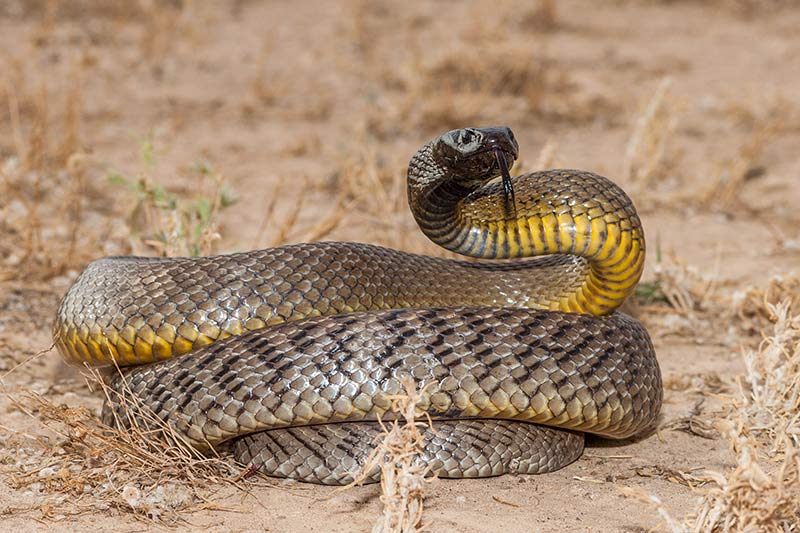
Also known as the fierce snake, the reclusive inland taipan is found in and around where the borders of Queensland, New South Wales, South Australia and Northern Territory come together. It hides in the cracks and crannies of the desert and, as such, reports of bites are quite rare. Nonetheless, this snake is known around the world as the land serpent with the most toxic venom of them all – one untreated bite is enough to kill an otherwise healthy adult in less than an hour.
2. EASTERN BROWN SNAKE
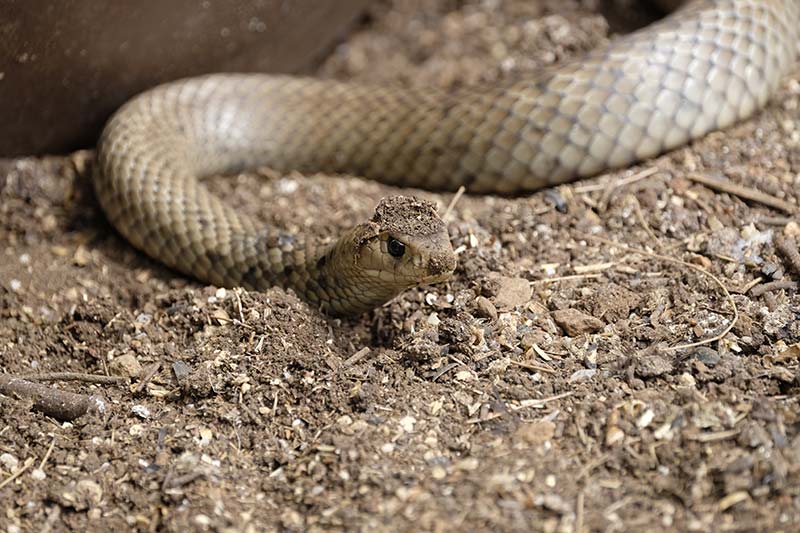
Arguably, this is the one feared by most Australians. Found in bushland, on farms, and sometimes even in backyards of the eastern half of the country, the eastern brown is fast, aggressive, and very dangerous. In fact, it’s responsible for most deaths caused by snake-bite in Australia than any other snake – it’s Australia’s second-most venomous terrestrial snake, and the world’s.
3. COASTAL TAIPAN
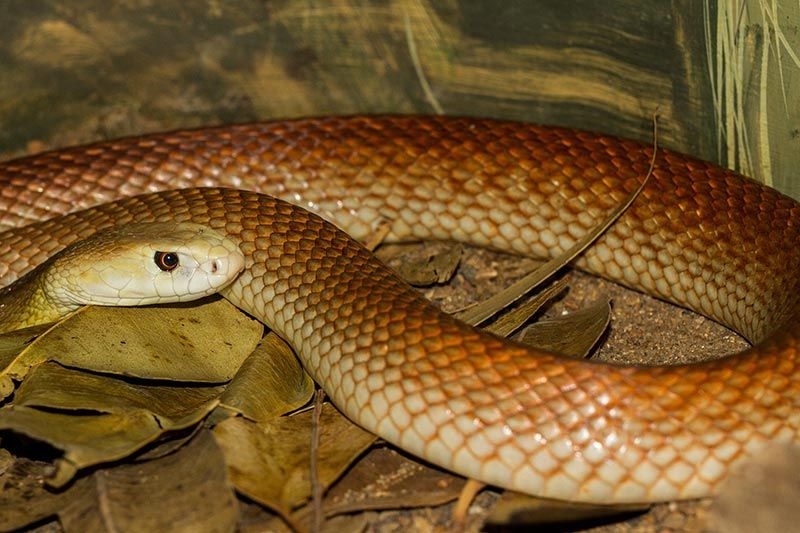
As if its very appearance wasn’t frightening enough, the coastal taipan sports the longest fangs of any Aussie snake. Making matters worse, its venom is the third-most toxic in the world. This unnerving creature is alert and ready to defend itself at the slightest provocation, though it’s not confrontational by nature.
Found along the east coast from the top of New South Wales to Cape York, and in Arnhem Land and further west, the coastal taipan has an average size of 2-2.5m. Avoid.
4. MAINLAND TIGER
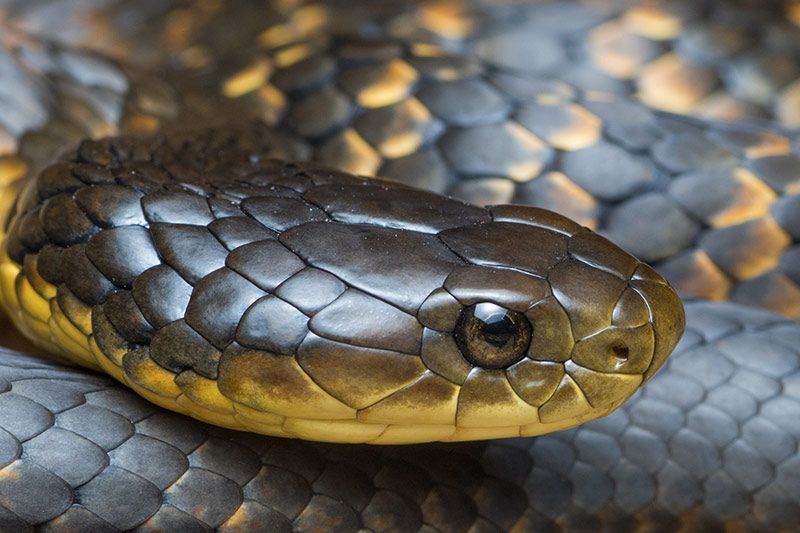
The mainland tiger snake is second only to the eastern brown in terms of reported bites. Found on Australia’s south-east coast and hinterlands, in parts of South Australia and southern Western Australia, they are generally characterised by their distinctive yellow and black bands along the length of their body; however, tigers can vary in colour depending on sub-type and location.
The bottom line: as we explore Australia, it’s essential to keep a watchful eye for anything that slithers. Sensible precautions are the best way to avoid a snake bite; preparation and education is the best way to survive one.


